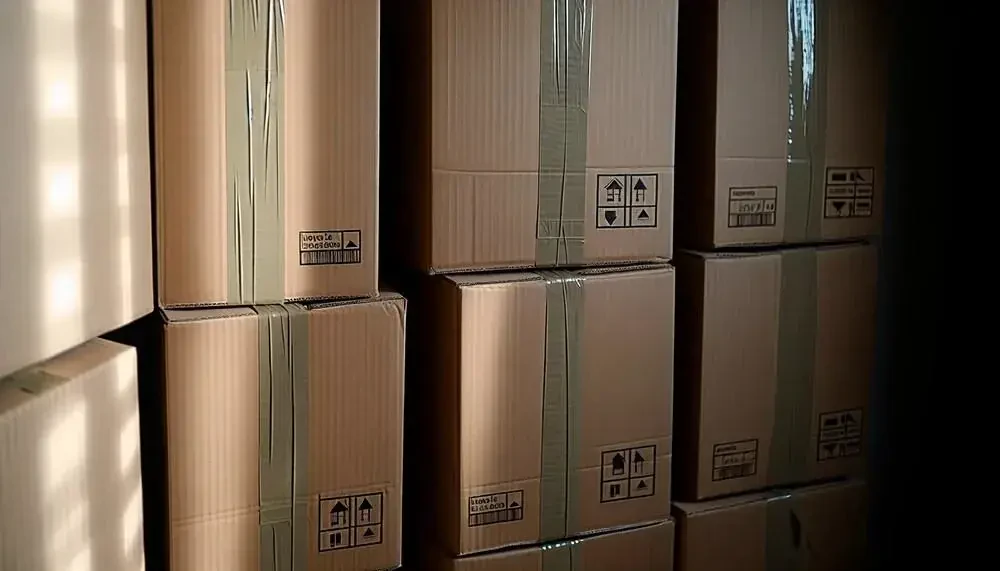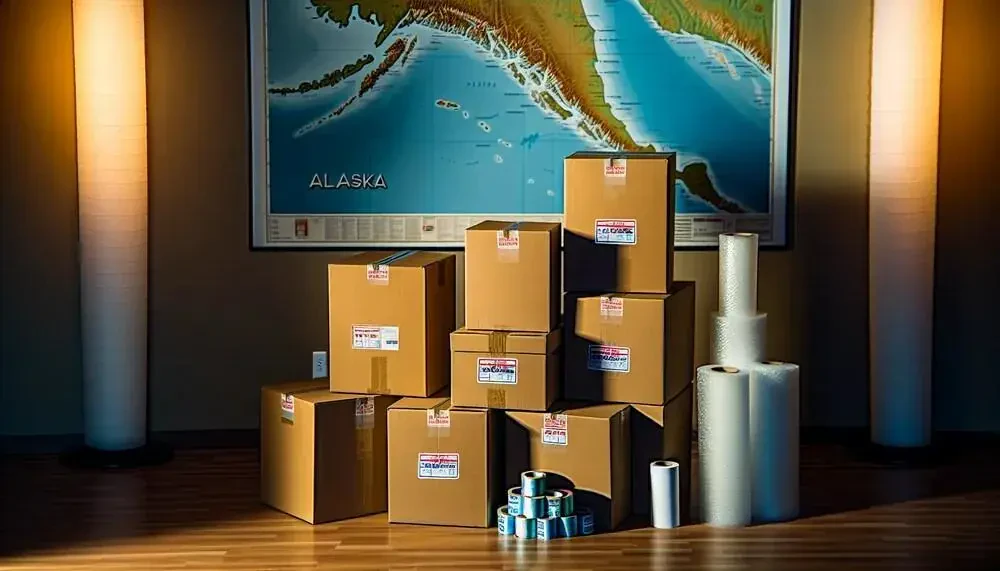Published by Chris Townsend
Last updated Nov, 29 2025

The average cost of movers in Alaska typically ranges from $5,020 to $8,020 for a local move and can be higher for long-distance moves.
Price Table for Moving Service
| Service Type | Basic Package | Premium Package | Deluxe Package |
|---|---|---|---|
| Packing | Included | Included | Included |
| Furniture Disassembly | Not Included | Included | Included |
| Loading | Included | Included | Included |
| Enclosed Transport | Not Included | Included | Included |
| Local Transport | Included | Included | Included |
| Insurance | Not Included | Included | Included |
| Delivery | Standard | Standard | Express |
| Storage Service | 5 Days Included | 10 days Included | 15 days Included |
| Price | $5,000 | $7,500 | $10,000 |
Understanding the Cost of Movers Alaska: What to Expect on Your Budget
Are you planning a move to Alaska, the land of unparalleled natural beauty, the awe-inspiring Northern Lights, and the Last Frontier? Relocating can be an exhilarating experience, but it’s essential to understand the costs involved, including the cost of full-service movers. In this blog post, we’ll provide a comprehensive breakdown of the various factors that impact the cost of moving, discuss the pricing structures of top removalists, and share tips to help you save money on your move. Let’s embark on this journey to make your relocation a breeze!
Key Takeaways
- This article examines the various cost factors of shifters, such as distance, volume and weight of belongings, seasonal fluctuations, and pricing structures.
- Strategies such as decluttering before a commercial move can help reduce costs when relocating to the state.
- Understanding Alaska's tax advantages may provide financial support for businesses or individuals looking to relocate there.

Breaking Down the Cost Factors
As you plan your Alaska move, considering the factors influencing moving service costs is necessary. Grasping these variables aids in managing your budget efficiently. We’ll examine cost factors like distance, volume, and seasonal fluctuations that affect your relocation.
Distance and Destination Variables
One of the most significant factors affecting the cost of cheap moving to Alaska is the distance and destination of your move. Longer distances generally result in higher expenses, while a local move within the state may be more affordable. For instance, the typical price per mile for long-distance hauling storage services to Alaska can range from 75 cents to $1.50 per mile, depending on the storage options you choose during the relocation process.
Your final destination within Alaska significantly influences the overall charges. Isolated areas or locations with challenging terrain and limited infrastructure often incur higher prices than more accessible locations. Getting a free estimate from several relocators gives a clear idea of your move’s cost.

Volume and Weight of Your Belongings
Your belongings' volume and weight will directly impact the cost of your move. Heavier and more oversized items require more transportation resources, which can increase the fee of moving services. For example, an increase in the volume or weight of your belongings may necessitate additional personnel and vehicles, resulting in a higher bill.
The estimated outlay of transporting large and heavy items to Alaska for long-distance moves is typically between $6,534 and $19,823. To minimize the price, it’s wise to declutter before the move, select an appropriate time to move, and consider utilizing benefits.
Seasonal Fluctuations in Prices
Shipping prices vary depending on the time of year, with peak seasons typically resulting in higher prices. The peak generally occurs between June and August, when the weather is more favorable, ranging from 45 to 70 degrees with 18 to 20 hours of daylight per week.
Relocating to the area during peak seasons may be more expensive than at other times of the year, with an average cost increase of approximately 20%. Planning your move during off-peak seasons can save you money on your Alaska relocation.

Pricing Structures
Evaluating the pricing structures offered by multiple, incredibly different moving companies is key as you plan your relocation. This comparison aids in making a well-judged decision while finding the best deal for your budget.
Let’s examine the pricing structures of top agencies, such as hourly rates and flat fees.
Hourly Rates Versus Flat Fees
When choosing a moving company for your Alaska relocation, it’s essential to understand the differences between hourly rates and flat fees. Hourly rates are calculated based on the number of movers and the hours required to complete the move. On the other hand, flat fees are calculated based on the weight of the items being moved and the distance of the move.
Both pricing structures have their advantages and disadvantages. Hourly rates offer flexibility, cost control, and transparency but may also result in uncertainty, potential delays, and lack of predictability. Flat fees, however, provide a fixed cost for the entire move, regardless of the duration, which can be helpful for budgeting purposes. To avoid surprises, it’s crucial to inquire about any hidden fees associated with both pricing structures, such as packing materials, fuel surcharges, and fees for handling special items.
Obtaining a Custom Quote
When planning your move to Alaska, obtaining a custom quote is vital to ensure accurate pricing for your needs. To provide a precise custom passage, moving organizations require the following information:
- Total weight of your inventory
- Amount and size of furniture
- Number of movers needed
- Any fragile items that require custom crating
- Any additional services you may require, such as packing or storage.
Instant online quotes for Alaska relocation can be reasonably accurate, but they may not offer the same level of detail or accuracy as official passages. To ensure the cheapest and most accurate pricing for your move, it’s advisable to follow up with a more in-depth survey or request multiple quotes from different companies to compare prices.
Additional Expenses to Consider When Hauling
Beyond the price of Hauling, other expenses are worth considering as you plan your move to Alaska. These might include packing supplies, storage solutions, and special handling for delicate items.
Let’s explore these additional costs in more detail.

Packing Supplies and Benefits
The expense of packing supplies and services can add up, so it’s essential to budget for these expenses when planning your move. Typical supplies required for a move include:
- Moving Boxes
- Packing tape
- Scissors
- Box cutter
- Marker pens
- Bubble wrap or paper
- Stretch wrap
- Plastic bags for smaller items
You can obtain supplies for your move in Alaska at stores such as:
- U-Haul
- The Packaging Store
- The UPS Store
- Alaska Warehouse Specialists Inc.
The average price of packing supplies varies depending on the size of your home, with larger residences costing approximately $200 for necessary moving and materials.
Storage Solutions During Transit
Storage solutions, such as a storage unit, may be necessary during transit, which can add to the overall outlay of your move. These solutions provide secure storage for belongings during the process, and they may be required during a long-distance move or if you need temporary storage before hauling into your new home.
The typical expenditure of short-term storage in Alaska ranges from $50 to $200 per month, while long-term storage can range from $100 to $400 per month. Some firms may offer free storage during transit, such as International Van Lines, which provides a month of free storage for long-distance moves.
Special Handling for Delicate Items
Special handling for delicate items may require additional fees, so factor this into your budget. Breakables such as china and glass shelves, large and fragile items like pool tables and hot tubs, and special items like plants and pets must be handled with extra care during a move.
The average costs associated with special handling of items by relocating can range from $250 to $1,500, depending on the distance and the services required. When relocating fragile items, utilizing specialized packing materials and methods is essential to guarantee they are not compromised during the move. You may also consider engaging a professional moving company specializing in delicate items.

Comparing Do-It-Yourself Versus Professional Shifting Expenses
As you plan your Alaska relocation, you might contemplate choosing between do-it-yourself or professional moving services. Each option carries its own set of costs and benefits. Carefully weighing these factors before making a decision is vital. Let’s compare the prices and benefits of both options to help you determine the best choice for your move.
Self-Moving Services: A Budget-Friendly Alternative?
It can be a budget-friendly alternative to hiring a professional firm but may require more time and effort. You can rent a portable container from a company such as U-Pack and handle packing, loading, and unloading your belongings.
The typical expense of shifting with a U-Haul U-Box or U-Pack to Alaska can vary, depending on factors such as home size and distance. On average, the cost of moving with a U-Haul U-Box is approximately $3,700, while U-Pack prices range from $700 to $6,600, depending on the move's size, destination, and distance.
Although it can be more budget-friendly, be prepared to allocate significant time and effort to the packing and process compared to hiring local movers.

The Value of Professional Assistance
Professional moving usefulness can provide added convenience and peace of mind. With professional haulers, you receive comprehensive services, including:
- Packing
- Loading
- Transport
- Unpacking
However, it’s important to note that professional assistance may come with a higher price tag.
The estimated cost of professional ranges from $5,334 to $19,823 for long-distance moves. While professional services can be more expensive than self-moving alternatives, they also provide the advantage of having a dependable team of movers to help plan and execute a successful move.
Ultimately, the choice between do-it-yourself and professional benefits depends on your budget, time constraints, and personal preferences.
How to Save Money on Your Alaska Relocation
Moving to Alaska can be expensive, but several strategies can help reduce relocation fees. This part shares tips on choosing the optimal time and decluttering before the move to help minimize expenses and maximize your budget.
Selecting the Right Time to Move
Choosing the right time to move can significantly affect your relocation costs. As mentioned earlier, off-peak seasons, typically from October to April, offer lower prices and increased availability of movers. By planning your move during these off-peak times, you can save money on fees and secure a more favorable schedule.
It’s also essential to consider the demand and supply dynamics when deciding the best moving time. When demand for services is high and supply is limited, expenses will likely increase. Conversely, when demand is low and plenty of haulers are available, prices may be lower as relocators compete for customers. Be strategic in selecting your date to maximize your budget.
Decluttering Before the Move
Decluttering before your move can help reduce the volume and weight of your belongings, potentially lowering your expenses. By discarding unnecessary items, you can save on packing materials, transportation expenses, and even the truck size required. Furthermore, decluttering can help to avoid the cost of storage units or additional space in your new residence.
To dispose of unwanted items before relocating to Alaska, consider organizing a garage sale or selling them online through Craigslist or Facebook Marketplace. By decluttering and selling unwanted items, you can save money on your move and generate extra funds to cover other moving expenses.

The Impact of Taxes and Government Incentives
Taxes and government incentives significantly affect your Alaska relocation. This section discusses the tax benefits of living in Alaska and the Permanent Fund Dividend (PFD), which provides additional financial support for residents moving to the state.
Understanding Alaska's Tax Advantages
Alaska offers unique tax advantages that can help offset the cost of living in the state. Unlike many other states, Alaska does not impose a state sales or income tax. This means that residents can enjoy higher take-home pay, which can help counterbalance the higher-than-average expense of living in the state.
Furthermore, Alaska has one of the lowest tax burdens in the country, with sixty percent of state and local tax collections coming from residents of other states. The absence of income tax can incentivize businesses and individuals to move, contributing to economic growth in the state.
Permanent Fund Dividend (PFD) Explained
The Permanent Fund Dividend (PFD) is a yearly payment to Alaska residents funded by oil royalties. Established in 1976, it was designed to conserve a portion of the state’s income from mineral resources to benefit future generations and attract new residents.
The annual dividend, known as the PFD, is calculated annually based on the balance of the dividend fund and the number of applicants. The dividend amount may fluctuate from year to year. To be eligible for the PFD, residents must meet certain requirements set by the Alaska Legislature.
The PFD can provide additional financial support for those moving to Alaska, helping offset living costs.
Summary
In conclusion, moving to Alaska can be a thrilling adventure, but understanding the various fees involved is crucial for a smooth relocation. By considering factors such as distance, volume, and seasonal fluctuations, comparing pricing structures of top organizations, and being aware of additional expenses, you can make informed decisions and effectively manage your budget. With the proper planning and strategies, you can make your Alaska relocation a successful and enjoyable experience.

Frequently Asked Questions
The average cost for hiring a moving company in Alaska is around $1,250 for a local move and up to $3,500 for a long-distance move. Be sure to compare different companies to find the best price.
On average, most movers charge between $30-150 per hour depending on the type of move and the number of people required for the job.
Alaska pays residents up to $3,284 for residing in the state via its Permanent Fund Dividend. This payouts are funded by Alaska's oil royalties and are divided equally among eligible residents. Additionally, no income or sales tax is imposed in Alaska.
Alaska is the fourth-most expensive state in terms of living expenses, with an average annual salary of $62,610 and an average total personal consumption cost of $54,331 per year. Moving to Alaska is therefore not particularly cheap.
Distance, volume and weight of your belongings, and seasonal fluctuations are the primary factors that influence the cost of moving to Alaska.
Weather conditions in Alaska can slow schedules, especially during heavy snow, icy roads, or strong winds. Movers may need extra time to travel safely or adjust loading plans. These delays can shift your pickup or delivery date, so planning some flexibility helps keep the move running smoothly.


